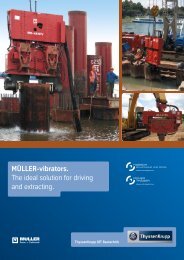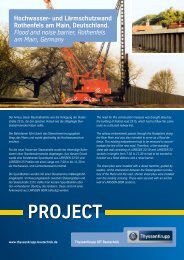MUELLER Vibrators EN - ThyssenKrupp Bautechnik
MUELLER Vibrators EN - ThyssenKrupp Bautechnik
MUELLER Vibrators EN - ThyssenKrupp Bautechnik
You also want an ePaper? Increase the reach of your titles
YUMPU automatically turns print PDFs into web optimized ePapers that Google loves.
Load plate<br />
Steel plate<br />
22 | 23 Special equipment.<br />
Custom solutions.<br />
Slab track e.g.<br />
“Rheda”<br />
<strong>ThyssenKrupp</strong> GfT Tiefbautechnik is a competent partner for special vibration technology<br />
applications. Our experts in geotechnical and soil engineering, machine design, control<br />
technology and electronics are available to support you at all times in the planning and<br />
execution of your projects.<br />
Vibrator Isolator Leader<br />
Clamp Carrier<br />
e.g.<br />
Thin diaphragm wall.<br />
Thin diaphragm walls are an economical way of providing vertical sealing in hydraulic and<br />
foundation engineering. This method is mainly used in dikes, dams, landfills and to contain<br />
subsoil contamination.<br />
To produce a thin diaphragm wall, a steel beam with a wider bottom end is driven into the<br />
ground to be sealed using a MÜLLER vibrator. The steel beam is equipped with flushing or<br />
slurry pipes. In this way, the gap created and part of the surrounding soil is filled/mixed with<br />
slurry. A roughly 50 cm deep flow trench in the narrow wall axis takes up excess slurry and<br />
compensates for slurry losses.<br />
By vibration driving the steel beam with an overlap, a narrow sealing element is created.<br />
Depending on the soil quality, wall depths of up to 30 meters are possible.<br />
©<br />
DYSTAFIT .<br />
5-fold clamping unit.<br />
Successful market entry with a newly<br />
developed adapter plate for five clamping<br />
units: The adapter plate makes it<br />
possible to arrange five clamping plates<br />
on a radius and so clamp and drive 5<br />
straight-web sections simultaneously. It<br />
has now been successfully used in India<br />
to construct 70 flat cells – an efficient<br />
way to counter buckling of the section.<br />
©<br />
Thanks to the patented “Dystafit ” system, necessary ground improvement and rehabilitation<br />
measures can now be assessed much more effectively. Load cycles are simulated<br />
©<br />
to predict the stability of ground susceptible to settling, sinking or shifting. Dystafit can<br />
also be used to test the effects of increased speeds on train lines.
















